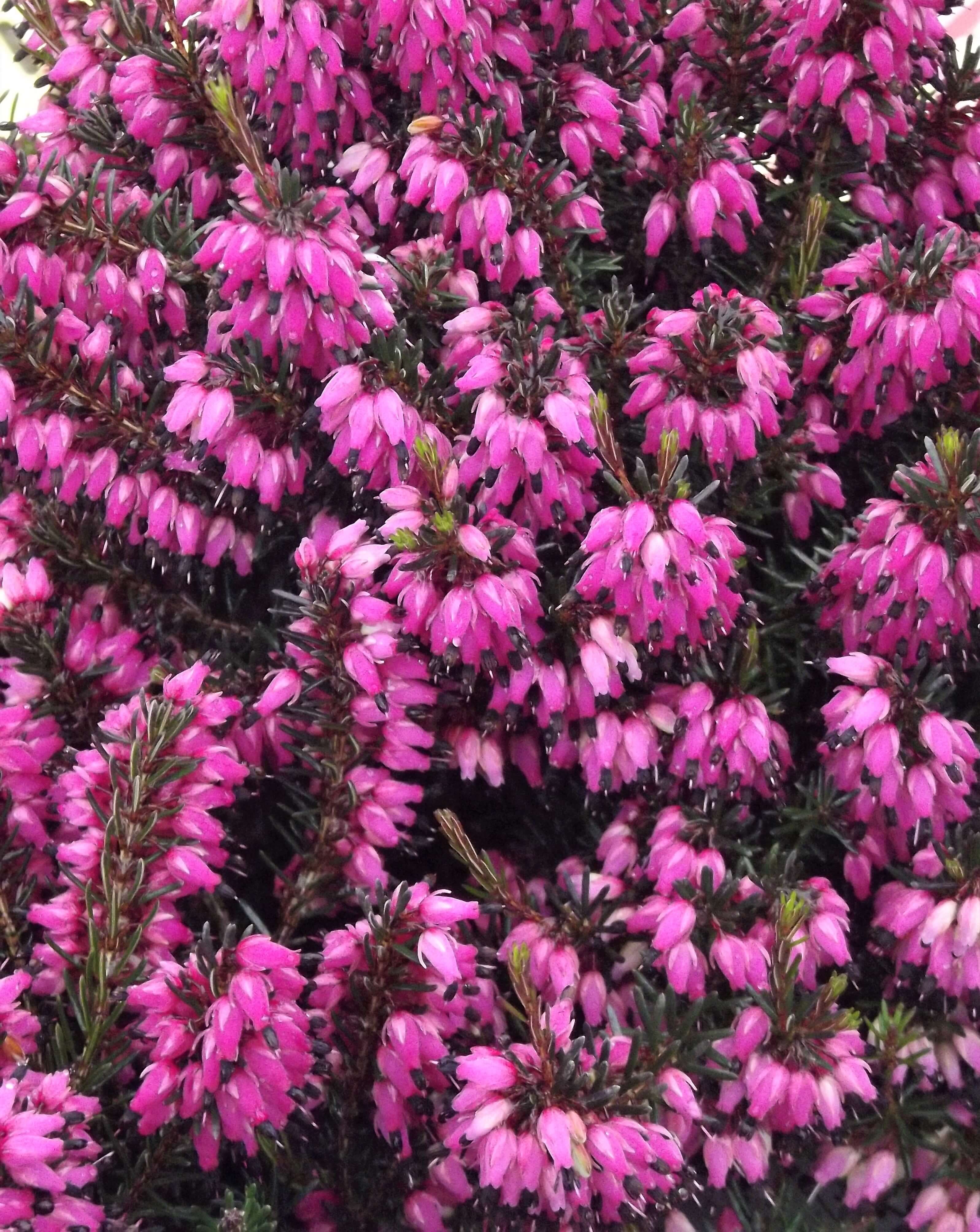I know it sounds like an advertising slogan from the 1950s but winter heather is better, particularly if you have had issues growing these plants in the past. Calluna vulgaris (Scotch Heather) is prone to root rot in our wet weather, Irish Heath (Daboecia cantabrica) is not as cold hardy at zone 6, and Summer Heather (Erica cinerea) dislikes our slightly heavier clay soils. However, both of the winter heathers (Erica carnea and E. x darleyensis) are quite resilient and relatively long-lived (20 years). Erica carnea is the most compact (6-8” tall) and cold-hardy (USDA zone 5) of these, as it is native to mountainous regions of Europe. Erica x darleyensis is a hybrid group (cross of Erica carnea and Erica erigena) of garden origin first discovered in the UK around 1900, which has given rise to many RHS Award winners including ‘Kramer’s Rote’ (‘Kramer’s Red’), ‘Jenny Porter’, ‘White Perfection’, and ‘Ghost Hills’.
As the common name implies, the flowering period is from late November right up to May, with some of the earliest blooming being Erica x darleyensis ‘Darley Dale’ and ‘Ghost Hills’. My top-selling winter heather is ‘Kramer’s Red’, as the deep magenta-pink flowers smother the dark green canopy from December to April and they do not readily show their faded brown blooms. That is almost four months of flowers, which when compared to the rather fleeting displays of rhododendron or azalea blooms is a regular marathon of colour. Winter heather is best planted in odd-numbered groupings (3s, 5s, or more) and allowed to grow together as a mass planting or drift because solitary plants just look like awkward, brightly coloured dots in the landscape. Planting can be done any time the soil isn’t frozen, although most of the four-inch plants purchased at this time of year are used as temporary colour in winter containers.
A few planting hints would be to go easy on the bonemeal (which temporarily raises the pH) as heathers are an ericaceous or acid-loving species. You can also add a little peat moss to your backfill soil. It is also important to use one-gallon specimens when mass-planting, particularly if you have dogs. I learned this lesson from an estate garden where the owner insisted on using hundreds of four-inch heathers for a bank planting; unfortunately, they also owned two Golden Retrievers who loved romping up that same slope, resulting in most of the juvenile heathers being snapped off at the base — this doesn’t happen with the established one-gallon specimens. You can also interplant different colours of heather (as long as the heights are staged properly) as the most common hues of white, shell pink, rose, and magenta pink combine rather well. If you are dealing with smaller spaces or planters, then consider using multiple-variety heathers which are usually marketed as ‘Candystripe’ or ‘Double Play’, with both ‘Kramer’s Red’ and ‘White Perfection’ (or ‘Alba’) cuttings grown together as one plant. There are also quite a few cultivars of gold-leafed winter heathers including ‘Eva Gold’ (a sport of ‘Kramer’s Red’), ‘Jack Brummage’, ‘Golden Starlet’ (a white-flowered Erica carnea), and ‘Mary Helen’, which I have a small drift of in my front yard. The latter bears pink bells from February to April and the bright gold foliage often takes on a bronze-purple hue in the colder weather.
As far as complaints about winter heather looking unkempt or ‘ratty’ after just a few years, I can assure you the problem here is a simple lack of pruning. Both Erica x darleyensis and Erica carnea require annual pruning after the blooms have faded, usually sometime in April. This can be done with a set of hedge shears, contour pruning most of the spent flower stems off without cutting so deeply that woody stalks are visible. When done properly and in a timely fashion, your heather will always have a dense foliage canopy with a flower display that will smother the contour. The other issue, at least with newly planted heathers is that they can dry out easily until they are rooted in, so be diligent with the watering in their first summer. Once established, heather plants are reasonably drought tolerant as they tend to shade their own roots and hold the moisture in.

'Nathalie'
While this is a great time of the year to go winter heather shopping, you still might be hard-pressed to find any Erica carnea as this is quite slow-growing and less popular with the wholesale nurseries who supply garden centres. Still, ‘Springwood White’ and ‘Springwood Pink’ are the most popular cultivars, with ‘December Red’ (pink fading to rose), ‘Pink Spangles’, ‘Nathalie’ (reddish-purple), ‘Wintersonne’ (rosy pink), ‘Rosalie’ (purplish-pink), Isabell’ (white), and ‘March Seedling’ (heliotrope) making occasional appearances. Beyond the aforementioned Erica x darleyensis varieties, the larger-flowered Winter Belle series such as ‘Lucie’ (magenta) and ‘Katia’ (white) are worth looking for, as are ‘Lena’ (magenta) and ‘Alice’. Also worth searching for are the AGM winning ‘JW Porter’ (mauve-pink), ‘Furzey’ (lilac-pink), ‘Arthur Johnson’ (cream new growth) as well as ‘Spring’ and ‘Winter Surprise’, both derived from the famous heather breeder Kurt Kramer.
Last but not least, I would like to remind you that the late winter / early spring blooms of both Erica carnea and Erica x darleyensis are an important forage for our native Bumble and Mason Bees.


